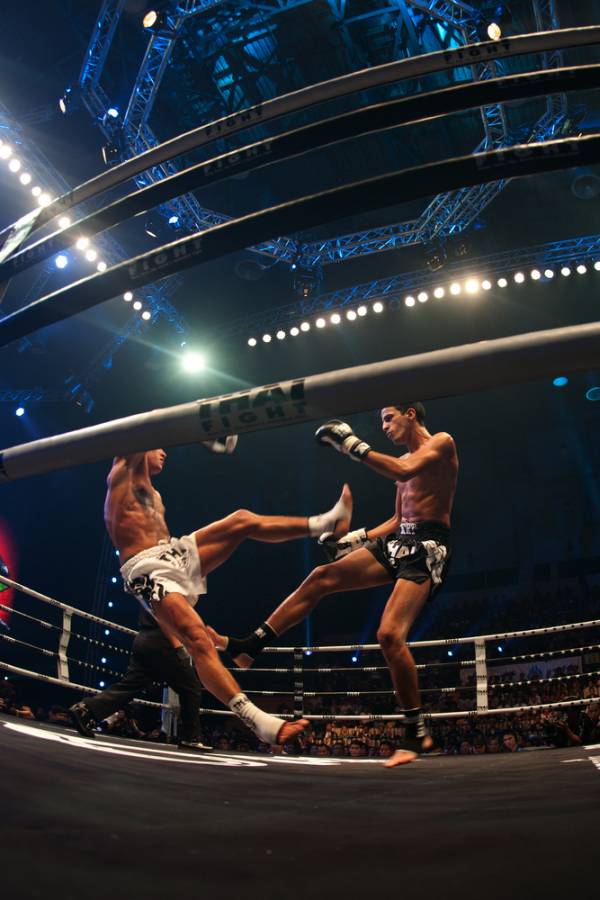Generally speaking, combat athletes are terrible strength athletes. The dogma of being ‘muscle-bound’ is still rife within the world of martial arts, but as readers of this site are well aware, just because you lift heavy things up and down it doesn’t necessarily mean that you can’t move well.
Thankfully, with the rise of the UFC and BJJ as more mainstream sports, as well as the influx of strength coaches who want to train MMA athletes, things are slowly starting to change – but we’re not quite there yet. Combat athletes still shy away from resistance training, often in favor of doing more cardio. I will always remember one occasion when I was taking two, decently-ranked, Bantamweight MMA fighters through their first training session with me, and neither one of them could deadlift 135lbs. with good form. In fact, neither one of them could do a decent push up!
If this sounds like you, then it’s time to embrace the iron.
Why Do Combat Athletes Need Muscle? Extra muscle provides the combat athlete a few significant benefits, including:
Added Strength and Power
Firstly, as a combat athlete, you want to be strong and powerful, and muscle is (in part) responsible for that. Being stronger than your opponent is a crucial advantage that can favor you in every aspect of fighting, from grappling, to wrestling, and striking as well.
Did you happen to catch Georges St-Pierre’s fight against Nick Diaz? GSP completely dominated Nick via his wrestling skill combined with a significant strength advantage. He held Diaz down, prevented many reversal and sweep attempts, dictated where the fight went, and ultimately won 5 rounds to 0.
Improved Knockout Potential
With the increase in strength and power comes improved knockout ability. Look at all the great knockout specialist in combat sports – most of them have a muscular frame from which they built their power. Guys like Hector Lombard, Junior Dos Santos, and Johny Hendricks are all walking examples of this.

Better Takedown Defense
For MMA, judo, or BJJ guys, more muscle will improve your foundational strength, making it harder for opponents to take you down, and making it easier for you to take them down. Not only that, but more muscle (especially in the lower body) provides you with a lower center of gravity, which means that you will be more likely to dictate where the fight is going to take place.
Decreased Risk of Injury
Think of your muscle as armor, protecting your body from nasty injuries. The more muscle you have, the more armor you have protecting you. That’s not to say that you can’t still get injured when you’re a muscular guy (or gal), but you’ll definitely be better protected with a layer of strong muscle tissue covering vital organs, such as your kidneys, as opposed to nothing but skin.
Fight Night Weight Advantage
Like it or not, weight cutting is a part of combat sports. More muscle gives a fighter the opportunity to outweigh his opponent (sometimes by a significant amount) come the night of the fight. The reality with these situations is that you can have a significantly heavier guy, who cuts weight really well, facing a guy that walks around daily at the weight of his division, and on fight night there could be 15-20lbs of difference between them.
GSP is reported to have his walk around weight being near on 20lbs heavier than his weigh in weight. It’s the same for Jon Jones, and Anderson Silva. They all cut significant amounts of weight to ensure that they stay at the top of their weight division, and never allow another fighter to have a weight advantage.
Rules For Adding Muscle To Combat Athletes
While building muscle is important for combat athletes, doing so isn’t a matter of picking up the nearest Flex magazine, and following Phil Heath’s latest program.
No, there are certain rules that you must follow to ensure your athletes don’t lose their athletic ability, or get big just for the sake of getting big. Remember, as as coach, your goal is always to make them a better fighter – it just so happens that sometimes this means packing on the pounds.

- Be careful of super high volumes: Combat athletes generally train themselves into the ground. The philosophy of ‘more is better’ definitely has a stronghold of the industry. While I disagree with this mindset, this is a tradition that doesn’t seem like it’s going to die any time soon. With this is mind, often fighters will enter the gym already feeling overworked and a bit banged up. The last thing they need is a training program that has a ridiculously high volume, which will only lead to them being run down even further.
- Build the muscle where it’ll count the most: Let’s make this real clear – combat athletes don’t need biceps the size of Schwarzenegger’s or traps to rival Mt. Everest. That is why bodybuilding programs don’t work for them. When you’re trying to add weight to a combat athlete, you need to preferentially add it to the areas where they’ll get the most benefit. From my point of view this means the legs, hips (glutes), core, upper back, and shoulders.
- Unless pressed for time, opt for the slow build: You should never add too much extra weight to an athlete too close to a fight. They need to be given time to adjust to carry the extra pounds around. Anyone who’s added a bunch of weight to their body over a short period will testify that, at least initially, you’re slowed down while the body adjusts to the new weight. If you’re in a technique-intensive sport, sometimes it can take a bit of time to get your timing back, so proceed slowly.
- Always be cognizant of their weight division and how much they’ve cut weight in the past: This is rather obvious, but has to be said. You don’t want to add so much weight to a fighter, only to have them being caught not being able to make weight, or worse, arriving to the fight completely drained of energy because they’ve had to cut too drastically. If need be, do a trial weight cut before the real weight cut, just to be sure that you’re going to make it, and that the fighter will still have the energy to fight at his or her best.
- If a fighter is going to be jumping up a weight division, ensure there is enough time between fights: In my opinion, the worst place for a combat athlete to be is at the lighter end of their weight division. This goes for MMA, BJJ, judo, or muay Thai – the discipline doesn’t matter. Every time you give up a weight advantage, you’re selling yourself short. This gets more important the higher up the ranks you get.
So if you’re a fighter who’s looking to make the jump to a heavier weight class, give yourself enough time between matches in order to add enough weight so that you can comfortably sit on the higher end of the weight class.
Sometimes as a combat athlete, you’re going to have to seriously look at adding some weight to your frame. Make sure that you build it right the first time, and don’t commit any of the common mistakes that make gaining muscle a hindrance, rather than a much needed boost to your fighting skill.
Photos courtesy of Shutterstock.






